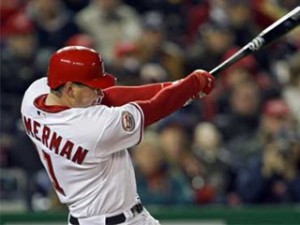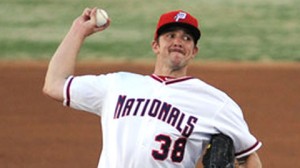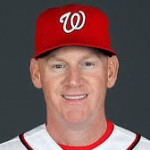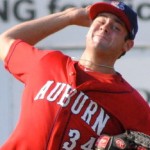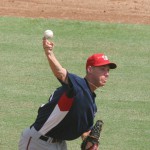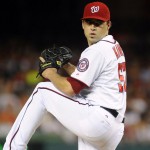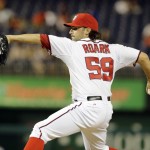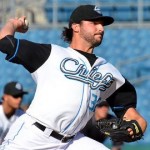I thought I’d do a different take on the “history of Nats drafts.” What was the mood/feel around the team approaching draft day year after year? Who do we think they were focusing on as the big day rolled around and why? We focus mostly on the first round pick, where so many of the mock drafts focus, but we’ll also mention significant moves further down.
To be honest, I didn’t really start closely following the draft and track who the Nats were “rumored” to be with until the 2008 draft. So if you remember something differently than me, please feel free to chime in. I also focus pretty heavily on the early picks here, simply because teams generally get the most value out of their 1st round picks, and the thought processes in taking the first round pick often is the focus of draft analysis and mock drafts posted head of each actual draft.
The Draft Tracker xls (created by Brian Oliver, now maintained by SpringFieldFan) is vital for any Nats fan interested in tracking the teams’ drafting history.
- 2005: Nats picked 4th overall and did not have a 2nd or 3rd round picks (the 2nd round pick went to Colorado for the Vinny Castilla FA signing and the 3rd round pick went to Minnesota as compesation for the Cristian Guzman signing)). The team was also under MLB control and was (presumably) given quite strict financial guidelines over signings. Given those considerations, they knew they needed a splash with their #1 overall pick, they needed someone affordable and they needed someone that would speak to their new fan-base. They wanted college draftees, quick to the majors. The team was looking at the three top 3rd Basemen in the draft. Ryan Zimmerman, Ryan Braun and Alex Gordon. All three were playing at good schools with good numbers. Gordon went 2nd overall to Kansas City and the Nats snapped up Zimmerman. Zimmerman signed quickly for an acceptable amount ($2.9M as the 4th overall pick) and was playing in the majors by September. Zimmerman’s selection made sense geographically (he grew up in Va Beach and attended UVA) and it made sense considering the talent available at the Nats pick. MASN’s David Huzzard printed a retrospective of the 2005 draft ahead of 2014’s draft.
- 2006: Thanks to a couple of FA losses (Hector Carrasco and Esteban Loiaza), the team had two extra picks in the first two rounds. The team had a roller coaster 2005; first place at mid-season and then a collapse as MLB refused to allow reinforcements. By draft-day 2006 the team was firmly under the control of Jim Bowden, and his philosophy had always skewed towards “toolsy” players, potential over actual. But the team didn’t have an owner yet, so were still operating under MLB’s guidelines. These two facts were quite evident by looking at the haul the Nats had with their early picks. 6 picks in the top 4 rounds and they were all high school players. Chris Marrero, Colten Willems, Stephen Englund, Sean Black, Stephen King and Glenn Gibson. The team got Marrero for a relatively cheap $1.6M deal mid-way through the first round, failed to sign Black altogether, and got 5 of these 6 players to sign for around $5M all told. The team on the field was under-performing thanks to a limited MLB-dictated budget, but Bowden was drafting for the longer run. Unfortunately none of these high school players ever amounted to much of anything, with only Marrero ever reaching the majors and Willems retiring before ever advancing out of A-Ball.
- 2007: The team had another haul of upper-end draft picks, thanks to their acquisition of Alfonso Soriano and his type-A free agency sending them both an extra first rounder and a supplimental first rounder. The team took lefty Ross Detwiler from small school Missouri State with the 6th overall pick, a selection that has been lampooned based on who else was available at the time (Madison Bumgarner and Jason Heyward in particular), but literature from 2007 supports his selection at 6th overall. After Detwiler, the nats spent their two supplimental first round picks on high school raw talents (as was Bowden’s custom), neither of which ever panned out (Josh Smoker and Michael Burgess). This draft turned into one of the more productive in Nat history, with at least four current major leaguers picked (along with Detwiler, Stephen Souza, Derek Norris and especially 2nd round pick Jordan Zimmermann, so it is unfair to focus on the misses out of 2007. This was easily Bowden’s best draft while in charge in Washington.
- 2008: The year of Aaron Crow. Crow had a strong summer and a strong spring and was the 2nd best college arm in the draft, no question. There was apparently antagonism between Bowden and Crow’s agents from the moment that he was drafted, and the negotiations between the sides never really came together. The signing deadline came and went with no signature, and Crow went to Indy ball before getting picked the following summer. There was talk about how the Crow non-signing was purposeful; the Nats spent significantly less money in the draft in 2008 than they had in 2007 and the ownership group was still being labeled as “cheap.” Either way, this lack of signing was one more bullet in the ammunition guns of opinion makers in the industry about the state of the Nationals organization under the leadership of Bowden. This would serve to be his last draft; he was embroiled in the bonus scandal over the off-season and relinquished his job ahead of the 2009 season.
- 2009: We all are quite familiar with the story by now; Stephen Strasburg was a laconic out-of-shape hurler in high school who barely merited a college spot, then re-made himself into the “greatest pitching prospect of all time” while at San Diego State. Despite his reported bonus demands (he ended up with more than $15M deal) and his representation (Scott Boras), the Nats never seriously considered not selecting him with the first overall pick. For me the big question was who the Nats were going to take at #10. I wanted another starter, and there were some significant college pitchers projected to be available at #9. Kyle Gibson, Alex White, Tyler Maztek, Chad Jenkins and Tanner Scheppers were all left on the board to draft a Stanford reliever in Drew Storen. Keith Law had Storen ranked as his 28th prospect, a guy who was clearly “good” but who was over-drafted by nearly 20 spots. This had “signability pick” written all over it, a thought that was even more proven when the team drafted college senior Trevor Holder with their 3rd pick and signed him for 1/2 of slot. Holder wasn’t even his team’s friday starter and had a 4.48 ERA. So, the team got Strasburg and paid him significant money, and the 2008 draft misstep turned into an effective closer in Storen, so the draft wasn’t a disaster, but with a bit more money allocated (remember, this was the same year they were paying Guzman $8M to be a mediocre shortstop) the team really could have hit it out of the park.
- 2010: After another 100+ loss season, the Nats were fortunate to have another no-brainer, consensus #1 overall pick in Bryce Harper. But the real story of the 2010 draft was Mike Rizzo’s finally convincing the ownership group and Ted Lerner of the power of the over-slot pick. The Nationals gave Harper a 40-man deal and a lot of guaranteed money … but they also bought two high-end high school arms out of their college commitments for 1st-2nd round money (A.J. Cole and Robbie Ray). The Nats were quickly becoming a team that was ignoring the advice of the penurious commissioner Bud Selig, known for railing against teams and owners who ignored his “slot recommendations.” The Lerners tried to be friends with Selig and play by the rules, only to watch other teams out-spend and out-sign them. Remember this fact when we see the next CBA come out, assigning slot deals ahead of time and implementing draconian policies on teams that over-spend in the draft.
- 2011: The Nats were looking at a handful of players with their #6 pick; George Springer, Sonny Gray, Taylor Jungman, Jackie Bradley, and the like. In a pretty shocking draft-day shake-up, teams passed on former college player of the year Anthony Rendon and suddenly he fell into the Nationals’ lap. The sliding of Rendon to the Nats was amazing; Rendon was considered a clear consensus 1-1 pick for nearly 2 seasons, and the pro track record of BA college players of the year is pretty solid. The Nats had two extra first rounders (compensation for type-A FA Adam Dunn) and the selection of Alex Meyer with the #17 overall pick was a given; some pundits had the Nats taking him at #6 overall, so much they were enthralled with the huge right hander from Kentucky. As with 2010, the team continued to write big checks to convince Brian Goodwin, Matt Purke and Kylin Turnbull to leave school early. The Purke pick in particular showed that the Nats were willing to spend money to get big-time players and were willing to risk the dice on injury concerns. The Nats had no 2nd rounder (lost as compensation for Adam LaRoche but with three 1st/supp-1st rounders got plenty of cracks at top-end talent.
- 2012: The Nats had a mid-draft pick after their .500 record in 2011 and were focusing on arms. By now, Rizzo’s drafting mentality has been made evident; he focuses on college players, and more specifically college arms, unless an outlier falls into his lap. Well, the definition of a draft-day outlier fell into the Nats lap in 2012 when Lucas Giolito, a big-time prep prospect who was under consideration of being the first ever high school right handed pitcher to go 1st overall early in the process. Giolito’s size, power and secondary offerings were the makings of a 1-1 pick, but his senior prep season was derailed by what was initially called an “elbow strain” but which turned out to really be a “small elbow ligament tear.” Nonetheless, the Nats grabbed him, signed him for over-slot money (nearly $3M), and they had their man. Years later, Rizzo revealed that the next guy on their draft board was St. Louis sensation Michael Wacha … a “what if” question for this team that may be asked for quite a while, given Wacha’s quick rise and overall dominance at such a young age. The rest of the Nats draft class was entirely about saving dollars to over-pay Giolito and buy him out of his college committment (as is seen by the bonus figures and senior draftees for the rest of the first 10 rounds), and we’re already seeing the after-effects of this strategy; the team has already released 10 of its 2012 draft class after just two pro seasons, and outside of Giolito its hard to see any potential impact players out of the entire class. The Nats may get a couple of RHP bullpen arms, but little else.
- 2013: The team knew it didn’t have a first rounder thanks to its signing of Rafael Soriano (though to be honest, knowing that they were picking last thanks to their MLB-best record in 2012, they probably weren’t as reticent about losing that pick), and the new CBA had taken affect, meaning that the team had a very limited budget for signing players. Their first pick wasn’t until the end of the second round, and they went with a big power college arm in Jake Johansen. It was impossible to predict who would be available to the Nats at the 68th pick (their first pick), so the Nats draft philosophy seemed to revert to default; lots of college players, lots of college arms. Of their first 15 selected players, just one prep player was selected (Drew Ward) and a number of their guys signed for significantly under-slot to pay Ward and a couple of other players.
- 2014: After a disappointing 2013 season, the team kept its first round pick in a draft that seems deep on college arms but thin in other areas (especially college hitters). The Nats farm system, after years of drafting predominantly college arms for the past few drafts, has plenty of arms but is thin on hitters, leading some pundits to presume the Nats are looking at college bats. But a couple of late spring elbow injuries on significant names (James Hoffman and Erick Fedde) also has other pundits thinking that the Nats will have no concerns about taking a pitcher who is known to need Tommy John surgery (given their handling of the likes of Strasburg, Solis, Zimmermann and their picking of Giolito in 2012). Mock drafts frequently have the Nats selecting Fedde at #18. And indeed that is who the Nats select. A run on high-end college arms just prior to the Nats pick probably sealed their fate on taking Fedde. They take a good balance of pitchers and hitters in the top 10 rounds, almost entirely out of the college ranks (as is their custom). Like 2013 and 2012, they gambled on one prep player in the top 10 (this year Jakson Reetz) and bought a high-end prep prospect out of his college committment, but otherwise stayed the course drafting college players.
The following links were crucial to doing this post:
- Nats Draft Tracker (maintained by SpringfieldFan)
- B-R.com’s Draft database of players.
